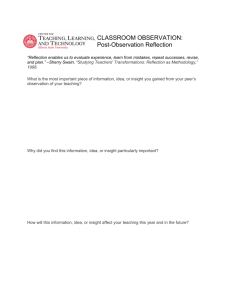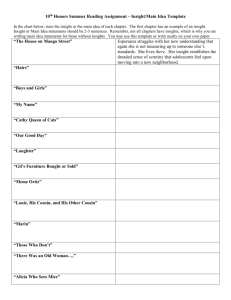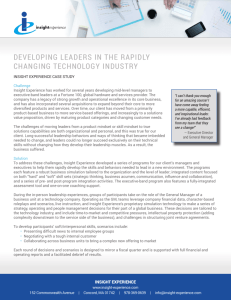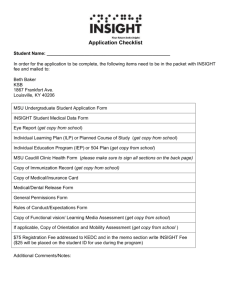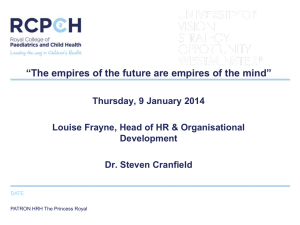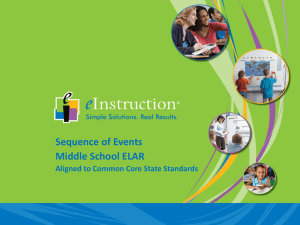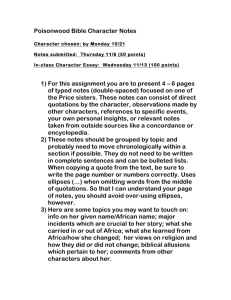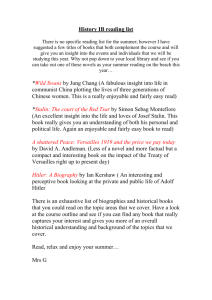Research for Branding - communication management
advertisement
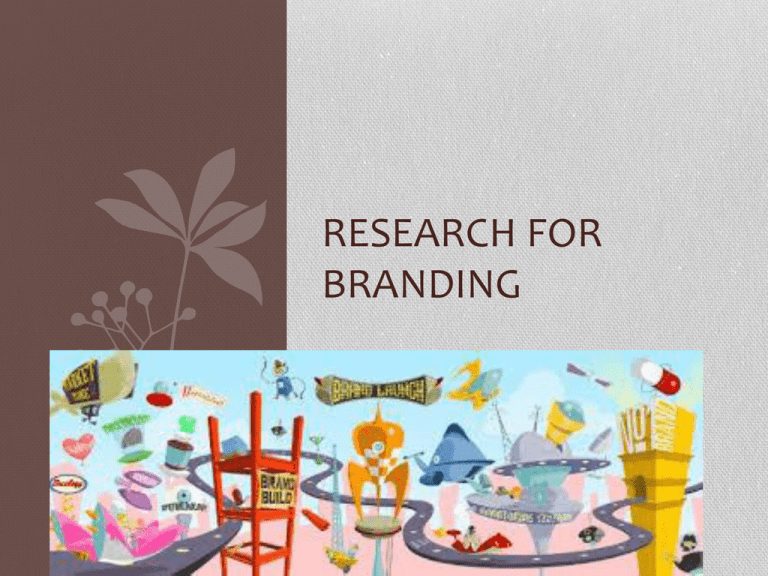
RESEARCH FOR BRANDING Why research? Research function Basic formulation Evaluation and valuation Developing a brand strategy is usually supported by research. The strategy will detail the goals and rationale for the brand, providing both information about the market and its place in the market, including competitor insights. It will also cover audience insights and brand values and, from here, key messages about the brand can be developed. A strategy will identify where a brand will differentiate and feed into the creative development process. Research and analysis of the market, as well as of the brand’s competitors and its audiences, are critical to any brand development. Many brand agencies will have specialist research teams (or freelancers) who focus on customer and social trends and insights. Research may be used at any stage in the brand process: from testing a brand name, to monitoring how people interact with a website or with a product on the supermarket shelf. Research option Branding research Self research /internal reseach Customer analysis Competitor analysis How to analyze? Internal Factor Analysis/ external factor analysis •Describe all factors – •Internal : find out your entity’s strength and weakness, •external : find out your entity’s opportunities and strength Making SWOT matrix -•Put the IFE / EFE results to the SWOT matrix •Give a points for each of IFE and EFE results – •Find out which one is the best way for your grand strategy CONSUMER ANALYSIS A customer analysis • A customer analysis may address the major trends that affect the brand as well as the motivation behind customer buying and changing audience attitudes. • Customer profiles are helpful here to ascertain the types of people that will buy into the brand, including their attitudes and needs, as well as in producing guidelines as to how to reach that audience. Consumer Analysis Trend Segmentation Motivation Consumer Insight Trend analysis TRENDING TOPICS LIFESTYLE IDOL ETC Motivation Motivation The driving force within individuals that implies them to action… (Schiffman and Kanuk, 2007) • what makes any living creature go in search of something whether it is lions seeking shade or customers looking for a cold drink. Motivation • process that lead people to behave as they do Motivation in marketing • it's all about finding out what your customers really need (and want and the difference between those two concepts) and what they are willing to do to get it. • It's also about finding out how much you, as the marketer, are willing to do to satisfy those customers. Content theories Motivation theories People has a set of needs which they pursue what motivates actual process of motivation.How to push someone to act -Process theories Individual set their goals and choose how to get the goals using a calculation process Motivation : content theories Freud : focus on consumers emotion and feelings Murray’s manifest Needs theory : 20 needs Maslow’s hierarchal needs Motivation : content theories Higiene (Herzberg’s two factor) ERG (existence, relatedness, growth) Mc Leland’s need theory Muray’s List of needs Abasement Achievement Affiliation Aggresion Autonomy Counteraction Deference Defendence Dominance Exhibiton Hermavoidance Infavoidance Anviolacy ( a composite or inafoidance, dependense, and counteraction) Nurturance Order Plat Rejection Seclusion ( the opposite of exhebition) Sentience Sex Succourance Superiority ( a composite of achievement and recognition) Understanding Maslow’s hierarchal needs Goal setting : Goal specificity, goal difficulty, and goal acceptance Motivation : process theories Reinforcement Theory/ operant conditioning => positive or negative factors or situation expectancy theory Consumer Involvement Involvement : •a person’s perceived relevance of the object based on their inherent needs, values, and interest. Object : • brand/product, advertisement, purchase situation.. AL OTHER ENTITIES Level of Involvement • consumption at the low end of involvement Inertia Flow state • when consumer truly involved with a product • EXCELENT LOYALTY Cult Product SEGMENTATION RESEARCH Segmenting Detail on MARKETING COMMUNICATION • Dividing the market into groups of people who have similar characteristics in certain key product-related areas Targeting • Identifying the group that might be the most profitable audience Segmenting and Targeting • Market aggregation strategy • When planners purposefully use one marketing strategy that will appeal to as many audiences as possible • Market segmentation • Assumes that the best way to sell is to recognize differences within the broad market and adjust strategies and messages accordingly 5-23 Types of segmentation Demographic segmentation Geographic segmentation Psychographic segmentation Behavioral segmentation • Sociodemographic segments • Niche markets • Defined by some distinctive trait Benefits segmentation 5-24 Targeting Targeting the right audience •The target is described using the variables that separate this prospective consumer group from others who are not in the market Profiling the target audience •Describing the target audience as if they are people you know •Used in developing media and message decisions 5-25 Consumer / customer INSIGHT Build a deep understanding of you potential consumer / customer Example of insight’s successfulness Consumer Insight consumer • n. •1) a person or thing that eats or uses something. •2) a person who buys goods and services for personal use: [as modifier] •consumer demand. •(Oxford dictionary 7th edition) customer • n. • 1) a person who buys goods or services from a shop or business. • 2) a person of a specified kind that one has to deal with: • he's a tough customer. • (oxford dictionary 7th edition) insight insight (1)• n. •1) the capacity to gain an accurate and deep understanding of something. •› an understanding of this kind. •2) Psychiatry awareness by a mentally ill person that their mental experiences are not based in external reality. •- DERIVATIVES insightful adj. insightfully adv. •- ORIGIN ME: prob. of Scand. and Low Ger. origin. •(oxford dictionary. 7th edition) Insight (2) •a clear, deep, and sometimes sudden understanding of a complicated problem or situation, or the ability to have such an understanding. •(cambridge dictionary ) Consumer Insight • Consumers can seem fickle and contrary, but when you have the right information they’re actually pretty predictable • Consumer insight focus on measuring and bring a deepen understanding of consumer (customer) from every angle, then give producers the tools and insights to make informed decisions http://www.nielsen.com/sg/en/soluti ons/consumer-insights.html • statements that capture a clear and deep understanding of a consumer's attitudes and emotions, and they are one of the key building blocks for a company to generate ideas for new products or new services http://www.greenbook.org/marketingresearch/defining-and-finding-insights-34853 Insight “Insights are short statements based on a deep understanding of consumer attitudes and beliefs. “Insights are unknown or overlooked knowledge about consumer behaviour and attitudes.” “Good insights are short statements that reflect a deep and clear understanding about consumers using words that a consumer would use.” “A great insight is a “deep discovery” about our consumer that can be leveraged to change behaviour or to grow a business.” “Good insights help to establish a connection between brands and consumers in fresh new ways.” “A great insight often gets the reaction - thank goodness, somebody finally understands me”. http://www.greenbook.org/marketing-research/defining-and-finding-insights-34853 clarity sudden Deep complex Insight Daily activities / habitual process For every action your consumers take – making a purchase, (decision making process) watching an advertisement, browsing a store, surfing the internet, Insight areas engaging in social media – Etc consumer’s mind Perception toward issues Classic Insight area Who, what, where, when, why Consumer’s think, feel, purpose and strategy Psychologies How’s their behaviour are conducted Function of consumer insight Product or concept testing; Maulana, 2010 Product features; what is important to our target Creative guidance; --.> basic to make a concept, product development, communication aproach etc Missing featuresemotion and feeling of our customers Information and Purchasing channelwhere are the customers will get inform, notice, get/buy oru pr oducts Key of consumer insight • Not only from brand manager , but also all of organization members (staff, owner) • need to be part of organizational culture • CI manager directing or collecting all insight • Insights are useless if its n’t actionable challenge : should be clear and executable Basic option: Consumer insight techniques • These techniques aim at revealing the consumer’s latent expectations, desires and visions: • • • • In-depth Interviews Creative Focus Groups Dialogue groups between consumers and service providers Lifestyle Screening http://www.cosight.com/consumer_insight_techniques.html Categories : Fourteen Options for Customer Insights Observational Ethnography : Anthropology comes to market research. •Ethnography is the study of people in their natural or "native" environments—where they live, work, shop, and play. It is a set of complementary techniques developed within the discipline of anthropology. (http://www.ethno-insight.com/ourservices_2.html) •observing target users in their natural, real-world setting, rather than in the artificial environment of a lab or focus group\ •. • The aim is to gather insight into how people live; what they do; how they use things; or what they need in their everyday or professional lives. Ethnographic Tool Kit •Ethnographic research relies on techniques such as observation, video diaries, photographs, contextual interviews, and analysis of artefacts such as for example devices, tools or paper forms that might be used as part of a person’s job. •Observations can be made at home, at work, or in leisure environments. People can be studied with their family, on their own, with work colleagues, or as part of a group of friends https://www.gov.uk/service-manual/user-centred-design/userresearch/ethnographic-research.html Basic Function • Ethnographic research can provide extremely rich insight into ‘real life’ behaviour, and can be used to identify new or currently unmet user needs. • This approach is most valuable at the beginning of a project when there is a need to understand real end user needs, or to understand the constraints of using a new product or service by a particular audience. • n a business or marketing research context, ethnography is used to uncover, interpret, and understand the consumer point-of-view and the hidden rules of environments. Whereas focus groups and surveys rely on self-reporting and memory out of context, ethnography provides a holistic view of consumers in the context of their daily lives. • There really is no substitute for the opportunity to experience what consumers experience. For example, consumers do not interact with your products and services in isolation; they are affected by changing family patterns, unseen cultural factors, and other products and objects in the proximate environment. • Ethnographic research is the best means for getting at these unspoken cultural and social patterns that shape consumer behavior. Ethnography can be used as a stand-alone technique or can be used in conjunction with other qualitative and quantitative marketing research techniques. Negative • The term ‘ethnographic’ can be misused, it’s currently a bit of a ‘buzzword’ with some agencies who may not fully understand the approach. Informant or participant • In principle, anyone could participate in this type of research. As with any user research, the recruitment of suitable participants is key. The full implications of the research should be fully explained to potential participants, as some may not feel comfortable with this level of intrusion in their lives. Timescales • Depending on the study needs and the approach, but 6-8 weeks from briefing to results can provide rich insight. It may take time to build trust with participants, and the analysis period needs to be sufficient to be thorough. • Ethnographic research can be expensive and time consuming, but this depends on the needs of a particular project. The benefits derived can be extremely valuable. Netnography • the conduct of ethnography over the internet – a method specifically designed to study cultures and communities online. • Popularized by Rob Kozinets, the premise is that we can learn a lot by observing the content and characteristics of online behavior. • The sheer volumes of publically accessible (and therefore observable) blogs, discussion groups, and other communities mean we have numerous places to observe online behavior. • Distinctions should be made between netnography and social media research. Netnography studies a particular group or community (often over some measure of time), much like an anthropologic ethnographic study would. Social media research typically seeks to measure attitudes and behaviors more broadly; it is common for social media research to gather data from many thousands of sources. • Unfortunately, these terms are sometimes used inconsistently, resulting in confusion. Social Media research • Easily track what is being said about your brand, product, or even competitors across social media sites. • A wide variety of tools are available, and the applications of social media research range from simple early warning systems (alerting you to negative word of mouth) to in-depth brand perception analysis. • For more in-depth social media research including sentiment analysis, customized reporting, and related services, check out Conversition’s evolisten, Crimson Hexagon, Cymfony, iTracks, NetBase and Nielsen’s BuzzMetrics Text analytic •Text analytics and social media research go hand-in-hand, but text analytics can be applied to any text source. • Whether it is website feedback forms, comments on your company blog, openended survey responses, or even customer letters, any bucket of text can be analyzed with text analytics tools. Directed Example of Biometric function on branding / marketing research hops (Interior / Window Design): •Eye tracking studies enable interior designers to choose color, lighting, architecture, etc. so as to subtly influence the customer's mood. This includes the use of eye catchers to attract passers-by and arouse their curiosity. Package Design: •Eye tracking can be used both to optimize the look and feel of the packaging as well as the experience of unpacking the product. Strong competition nowadays between the huge variety of products makes the package design a key issue influencing sales. Advertisements / Print: • Eye tracking allows you to measure what your customers see and therefore to optimize your message with regard to the intended target group. Web Design / Online Marketing: • In web design, the aspect of optimized navigation through the content is of major importance. Therefore, the design demands more than the purely visual aspect. Usability tests can help you evaluate ease of use and logical navigation – both of which are essential for keeping the user on your website for as long as possible. http://www.smivision.com/en/gaze-and-eye-trackingsystems/applications/market-research.html Neuromarketing (as a research) •A very close but distinct cousin to biometrics, the neuromarketing concept seems simple enough: by imaging or monitoring brain activity, we can objectively measure human response to visual displays or other experiences. Neuromerketing : big question? • However, opinions on validity, best practices, and even ethics of neuromarketing are diverse. • Yet, there are plenty of avid believers, and the idea that we can measure brain activity to determine what is going to be most effective (such as in an ad, product package, and in one famous case, even a magazine cover) is enticing. Expert interviews • Forget the phone tag, scheduling hassles, recording errors, and transcription delays of yesterday. • Now by simply tapping into existing communities, you can get expert feedback on your burning questions within a day. • At a minimum, posting questions on discussion groups is a great way to generate or refine hypotheses—always an important part of the research process. • Check professional association communities, LinkedIn Groups, and MeetUp Groups to find relevant experts. Instant pools and mobile reseach • You can do a pool in a social media or mobile • Mobile research simply leverages the fact that most people have mobile phones—so why not send the survey to the most convenient device? • many companies now offering specific products fo instant pools such as SurveySwipe, Vovici and Zoomerang, survey monkey, etc • How cool is that? Sure, one can argue that it is not true “market research”, but it can still be a useful data source. Market reseach online community (creating a new commuity) • CMMC (Community Marketing and Management Council) defines a “community” as “a group of people who have been brought together, or have brought themselves together, under a common umbrella And who are having a conversation with each other.” community : natural vs created • examples of online communities: • Dog lovers • Golf enthusiasts • Heavy users of a specific category or brand • Stay-at-home mothers of small children • Fashion-conscious women who buy expensive purses • Brand advocates or brand enthusiasts • In contrast to naturally occurring communities, online communities may be created or recruited. http://www.decisionanalyst.com/services/onlinecommunities.dai Video Research •New platforms are available that allow you to collect video-based research input. Maybe you want to see facial expressions. In some projects, emotional response can be very important. •Or maybe you just want to give research participants an alternative mode of sharing feedback. •Ask Your Target Market (AYTM) is one such survey provider with a panel of webcam-equipped research participants available, Mindswarms is another. • SurveyGizmo has hinted it will be adding video response support by year-end 2011. Ideation and concept testing Crowdsourcing • is often associated with the idea of having work completed, such as for design projects facilitated by sites like 99Designs and Crowdspring. as “living” encyclopedia. •Crowdsourcing also includes the broader concept of asking a “crowd” for opinions or information •Ex : An informal approach is to ask a question about market trends on a networking site such as LinkedIn. • Another option is to ask Facebook fan page members what they think, for example, of a new ad. •One could even argue that hosting a contest—such as asking customers to submit videos or tag lines— is a combination form of market research and crowdsourcing; by looking at the themes contestants focus on, the brand learns what is important to customers. Idea Management •A common market research task is to discover customer needs and wants—sometimes in general, sometimes for a specific brand or product category. • Platforms now exist that allow you to generate and assess ideas from select groups of interest—such as customers, employees, or broader groups. •By creating an engaging user interface, these platforms make it easy for participants to submit ideas, vote on ideas and engage in conversations. •Example : BrightIdea, IdeaScale, Spigit, and many more. •If you have not heard of “idea management” before, think of it as a combination of idea brainstorming and concept testing rolled into one. • Ex : Like coffee? Then check out the publically accessible example at MyStarbucksIdea. Prediction Market • The categories of idea management and prediction markets overlap a bit. From a market research perspective, the key point is simple: using a web-based tool to generate, prioritize, and assess ideas (which, in this context, are predictions). • Maybe you want to know what behaviors will be more common in your target market by 2015? Or which of several new product offerings will have the most demand in the next 12 months? • Ask the crowd, whether a broad or narrow one, by hosting a prediction market. IdeaScale, Infosurv, and Inkling are just three of the platforms that offer free trials.* Some astounding results, in terms of prediction accuracy, have been reported in case studies by Best Buy and The Iowa Electronics Markets, among others. Successful customer insight needs (James, 2014): High level championing Interpretation over computational skills A constant beta mentality Automation of everything that can be automated Technology that makes things simpler http://www.marketingweek.co.uk/customerinsight-a-luxury-or-a-key-competitiveadvantage/3007893.article EXAMPLE OF CONSUMER INSIGHT RESEARCH TITLE : • Wedding Organizer: Consumer Insight And Market segmentation METODE • İnterpretative approach, qualitative • etnography. Data collection • Observation, unstructured interview, Data analysis technique • framework the theater metaphor. Research results •Segmentation research •Markt segment wedding organizer : • the socialite, the wedding dream, the workaholic couples, the not idea at all, the wishy washy, dan the thrifty. •A Consumer insight •Insight of wedding actor : bride, groom, parents, core family, extended family Stakeholder Bride Insight Information needs, center of attention, emotional, perfectionist -- bridezilla Groom Wedding party is a women area, rational, deppressed Parent It’s their business, authority, Budget, details , influenced by others (esecially extended family) Family (core family Information gathering, give an advice, : sister/brother) helpful Extended family Helpful but Over act, bossy, ask privilege, AHA MOMENT • -> princess / ladylike ; glam – focus on the bride and parents
